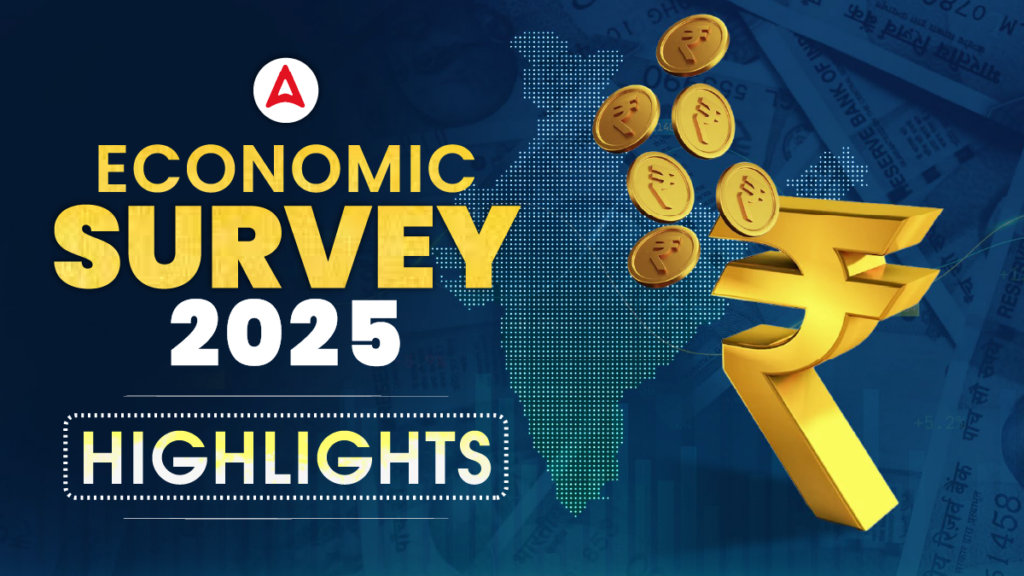On January 31, 2025, Finance Minister Nirmala Sitharaman presented the Economic Survey for the fiscal year 2024-2025. This document offers an in-depth analysis of India\’s economic performance, future projections, and key challenges. Structured into thirteen chapters, the survey covers various critical aspects of the economy. Here’s a detailed breakdown of its key highlights.
1. Macroeconomic Overview
- GDP Growth: India\’s real GDP growth is projected at 6.4% for FY25, with expectations for FY26 ranging between 6.3% and 6.8%. The primary drivers of growth include strong private consumption and investment, despite global economic uncertainties.
- Gross Value Added (GVA): GVA is forecasted to grow by 6.4%, reflecting healthy domestic demand and capital expenditure.
- Inflation Trends: Retail inflation has softened to 4.9% (April-December 2024), nearing the Reserve Bank of India’s target of 4% for FY26.
2. Sectoral Analysis
Agriculture and Allied Sectors
- Expected growth of 3.8% in FY25, supported by record Kharif food grain production of 1,647.05 LMT.
- Key contributors include horticulture, livestock, and fisheries, along with increased renewable energy adoption benefiting rural economies.
Industrial Sector
- Anticipated growth of 6.2% in FY25, driven by expansion in construction and utilities.
- Challenges include weak global demand impacting manufacturing exports and monsoon variations affecting mining and construction.
Services Sector
- Projected growth at 7.2%, with services exports rising by 12.8% (April-November FY25).
- Strong performance in financial services, real estate, professional services, and public administration.
3. Investment and Infrastructure Growth
- The government continues to emphasize infrastructure investment as a key driver of economic growth.
- Initiatives like the ₹50,000 crore Self-Reliant India Fund are set to provide equity support to Micro, Small, and Medium Enterprises (MSMEs).
4. Inflation and Price Trends
- Inflation management remains a priority, with retail inflation decreasing from 5.4% in FY24 to 4.9% in FY25.
- The Consumer Food Price Index (CFPI) has seen slight increases due to higher food prices but is expected to stabilize as per RBI forecasts.
5. Banking Sector Performance
- The sector has strengthened, with non-performing assets (NPAs) reduced to a twelve-year low of 2.6% of gross loans.
- Strong capital buffers, with the capital-to-risk-weighted assets ratio (CRAR) at 16.7%, well above regulatory requirements.
6. Employment and Social Indicators
- Unemployment has declined to 3.2%, compared to 6.0% in 2017-18.
- Government health expenditure has increased significantly, reducing out-of-pocket healthcare costs for citizens.
7. Fiscal Challenges and Policy Recommendations
- The survey highlights potential hurdles such as food inflation, taxation policies, and demographic shifts that could impact economic growth.
- Structural reforms are recommended to sustain long-term development amidst global uncertainties.
Conclusion
The Economic Survey 2024-2025 presents a cautiously optimistic outlook for India’s economy, demonstrating resilience despite external challenges. It underscores the importance of strategic policy management to maintain robust domestic growth.
With key fundamentals in place—such as controlled inflation, a strong banking sector, and increased investment—India is well-positioned to achieve its long-term vision of becoming a developed nation by 2047. However, managing inflation and ensuring inclusive growth will be essential for sustaining this positive momentum.



